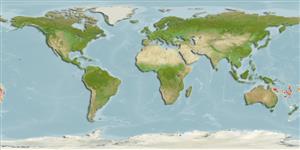>
Gadiformes (Cods) >
Macrouridae (Grenadiers or rattails)
Etymology: Coelorinchus: Greek, koilos = a hollow + Greek, rhyngchos = jaw (Ref. 45335); sereti: Named for Bernard Séret, ORSTOM.
Eponymy: Dr Bernard Séret (d: 1949) is an ichthyologist and marine biologist who is a senior scientist at IRD (Institut de Recherche pour le Développement) and is currently hosted by the Department of Systematics and Evolution, Muséum National d’Histoire [...] (Ref. 128868), visit book page.
More on authors: Iwamoto & Merrett.
Environment: milieu / climate zone / depth range / distribution range
Ecologia
marinhas batidemersal; intervalo de profundidade 412 - 825 m (Ref. 35908). Deep-water
Western Central Pacific: New Caledonia and Chesterfield and Bellona Plateau.
Tamanho / Peso / Idade
Maturity: Lm ? range ? - ? cm
Max length : 45.0 cm TL macho/indeterminado; (Ref. 35908)
Descrição breve
Chaves de identificação | Morfologia | Morfometria
Espinhos dorsais (total) : 2. Snout long, narrow, sharply pointed; orbit about 1.4, internasal about 2.0 into snout length; anterolateral margin completely supported by bone. Orbit diameter 1.2 of interorbital width. Mouth small, upper jaw slightly less than orbit diameter. Subopercle terminates in long slender tip. Dermal window of light organ small but prominent, external length about equal to length of posterior nostril. Anus slightly removed from anal fin. Underside of head covered with small prickly scales except along margins; nasal fossa and top of snout scaled. Body scales with 6 to 8 widely divergent spinule rows, middle row largest. First dorsal dark dusky, other fins dusky; body lacking distinctive markings in adults, but with faint to prominent saddles in young; mouth black, gums dark.
A benthic species found on the continental slope (Ref. 75154).
Life cycle and mating behavior
Maturidade | Reprodução | Desova | Ovos | Fecundidade | Larvas
Iwamoto, T. and N.R. Merrett, 1997. Pisces Gadiformes: Taxonomy of grenadiers of the New Caledonian region, southwest Pacific. Mem. Mus. Natl. Hist. Nat. (176):473-570. (Ref. 35908)
Categoria na Lista Vermelha da IUCN (Ref. 130435: Version 2024-2)
Ameaça para o homem
Harmless
Utilização humana
Ferramentas
Relatórios especiais
Descarregue XML
Fontes da internet
Estimates based on models
Preferred temperature (Ref.
123201): 6.2 - 10.1, mean 7.7 °C (based on 123 cells).
Phylogenetic diversity index (Ref.
82804): PD
50 = 0.5000 [Uniqueness, from 0.5 = low to 2.0 = high].
Bayesian length-weight: a=0.00245 (0.00126 - 0.00477), b=3.19 (3.02 - 3.36), in cm total length, based on LWR estimates for this Genus-body shape (Ref.
93245).
Nível Trófico (Ref.
69278): 3.6 ±0.5 se; based on size and trophs of closest relatives
Resiliência (Ref.
120179): Baixo, tempo mínimo de duplicação da população 4,5 - 14 anos (Preliminary K or Fecundity.).
Fishing Vulnerability (Ref.
59153): Low to moderate vulnerability (35 of 100).
